Japan Revealed – Sakura Included
Japan tour April 2019
Make sure to check out our gallery at the bottom of the post!
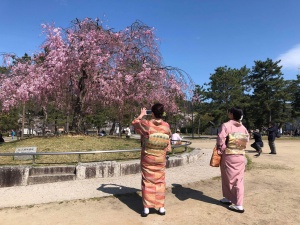
Everyone celebrates blossoms
Spotting Cherry Blossoms in Japan during most of the year generally involves looking at posters, paintings or even traditional clothes. But during spring (later March through April), and when the weather cooperates, the trees erupt with pink flowers.
Spotting Sakura (Cherry Blossoms) is akin to Pubs in Ireland or buildings in Tokyo – sure it is worth pointing out a spectacular one, but they are so much part of the landscape as to virtually define it.
We could not have timed this trip any better – so please do not expect your photos of Japan to look the same any other time of the year!
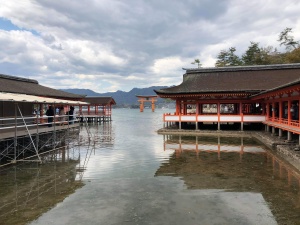
Itsukushima Shrine, Miyajima (just south of Hiroshima)
This outstanding tour of Japan managed to include quality time at a majority of Japan’s most famous sites.
This tour through the Land of the Rising Sun began (as it should) in Tokyo and looped south down to Fuji, Kyoto, Hiroshima and back up to Okayama, Kobe and out of Osaka. Of course it included two bullet train rides, many temples, boat trips and, of course sushi.
My group of 31 was particularly friendly and enthusiastic. A first night cruise / dinner / open bar and Karaoke should probably be included on every trip (anywhere on earth).
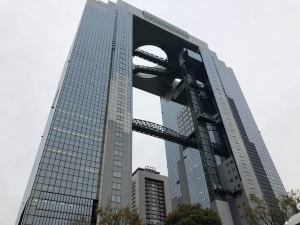
The ‘floating garden’ tower (Umeda Sky Building), Osaka
As I have previously written, Japan is a land of contrasts. Traditional, conservative and introverted, yet extremely polite, clean, efficient and, arguably sterile. The vast swathes of concrete buildings can be monotonous, yet mountain forests are protected, and it seems each spec of flat land cultivated.
Everything works in Japan and the overwhelming sense of safety is reassuring. The language barrier is substantial, but certainly not insurmountable. Toilets are heated and and take care of everything ;).
Tokyo
The actual administrative city is home to about 13 million people, but in an urban sense, massive, sprawling Tokyo is the world’s largest city with around 38 million people. That is roughly 1/4 of Japan’s 127 million, squeezed mostly along the coastline of the volcanic and tectonically active archipelago.
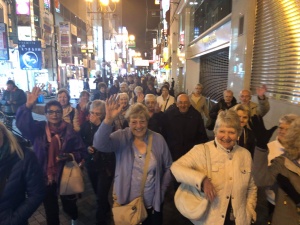
Out for dinner in lively Osaka
For such a massive city, Tokyo is very accessible. It is busy, but not hectic, clean, but reasonably polluted. Green space is rare, but cherished. From Narita airport the drive into the city is about an hour. For our first night we walked to a local restaurant and began sampling local cuisine.
On our city tour we visited the obvious sites; the Imperial Palace from the outside (Japan is still a monarchy, despite the regime’s collapse at the end of WW2).
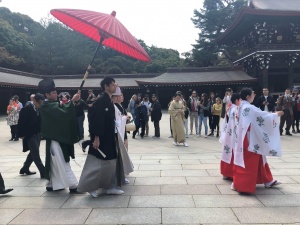
A Sunday wedding in Tokyo
Then we carried onto Meiji Jingu Temple. A more contemporary temple, we were lucky to visit on a Sunday and saw several weddings and even a car being blessed.
Then on to modern, busy Shibuya – in fact the busiest intersection on earth! Tokyo (originally Edo) did not rise in importance until the capital moved into the 19th century. Due to growth, earthquakes, fire and, of course, World War 2, almost the entire city has emerged over the past 70 years and is distinctly high-rise. Our excellent hotel is on reclaimed land in the Daiba district.
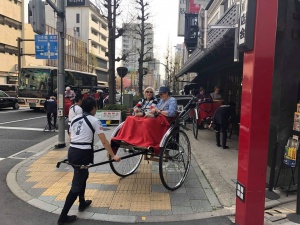
Rickshaws
In Shibuya, the group found their own lunch and some worked out the restaurant ticket machines (or went to Macdonald’s). Press a button, pay, take ticket, then sit and have a nice lunch. This is distinct from the endless vending machines, or the convenience stores that serve full meals and fresh sushi! Eating in Japan is both easy and confusing. Little restaurants have plasticized models of their food at the entrance. Point and eat.
In the afternoon, we were transported around the Asakusa Temple area in transitional rickshaws. Honestly well worth the effort. The ‘drivers’ offer an excellent example of how good service can be in Japan. Many in my group really wanted to tip … this is gradually becoming more acceptable – but only guides and perhaps drivers (not in restaurants – and no haggling).
Then to Tokyo tower – the modern city’s original broadcasting tower, modelled after a similar structure in Paris. That was fun from a higher perch, the common smog in such a huge city becomes more obvious.
Tokyo, as with virtually all Japanese cities, is defined by water. Rivers, canals and many inlets define the city. Japan’s mountainous backbone offers a natural barrier to urban growth. To that end we went out cruising and sampling some excellent Japanese cuisine. Of course the highlight was the open bar and Karaoke.
Karaoke while cruising Tokyo
Fuji
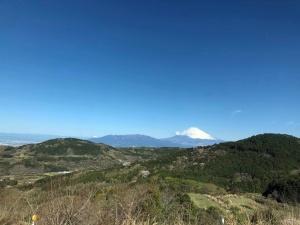
Leaving Tokyo, we went south towards famous (and active) mount Fuji. Japan is home to 127 million people. Most live on Honshu Island, which is smaller than Great Britain. Adding to the fun is an active chain of volcanoes and all the earth-shaking fun that can be offered by the Pacific’s ‘Ring of Fire.’
It was cloudy and raining at the mountain (but don’t worry, we saw it the next day). Soldiering on, we still had our pirate boat ride on Lake Ahai, Hakone and even with no view, we could smell the sulphur up on the volcano.
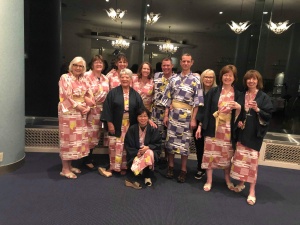
Dressing up (?) for dinner at a classic thermal springs hotel, Atamai
The evening’s hotel in Atami was classic Japanese with the real Onsen experience. Onsen is hot spring, or thermal pool. Sorry, no photos as everyone is naked. Some of us came to dinner in our Kimono ‘house coats.’
Fuji itself is a classic, conical volcano and is the most climbed mountain on earth. There are even vending machines on top! Seriously.
We were treated to beautiful views on our way to the train station for our first of two trips on the Shinkansen (bullet train).
Smooth and incredibly fast, two hours later we arrived to Kyoto, Japan’s historic capital.
Kyoto and area
Regardless of fatigue, we squeezed in as much as possible the first day in the sun as the forecast for rain was absolute.

Uji Temple – as seen on the 10 yen coin
Kyoto is of course a modern Japanese city, but dotted with temples, shrines and older neighbourhoods.
During our three days we mixed old with new and even enjoyed a tea ceremony in Uji. The Cherry Blossoms made everything perfect and the crowds reminded us we were in Asia!
Kyoto is perhaps the most visited city in Japan. When the trees are in blossom, Japanese love to rent traditional outfits and take selfies. Of course for visitors from abroad, it all feels fun and crowded.
During our time in Kyoto, we travelled out to green Nara with shrines, temples and seriously indulged deer. As I live in a national park, it seems strange to see people feeding – and even trying to hug the animals.
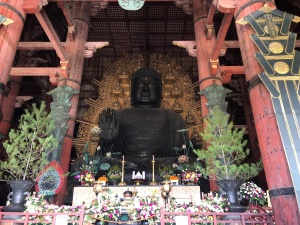
Big Buddha – Japan mixes several religious traditions, but is really not a society of faith
Setting aside the circus, the massive Buddha in Todai-ji temple is really impressive.
In the evening we ventured down the road to Osaka. Recently rated 3rd best city in which to live, the greater Osaka-Kobe-Kyoto metropolitan area is home to nearly 20 million people. This is massive, clean and well run.
The ‘floating garden’ or Umeda Building does not offer any green, but is one of the world’s great architectural works of art. Going from modern to sensory overload, Osaka’s Dotonbori district is the antithesis of ancient Japan. Bright lights, big city – with dragons, crabs and every sort of animation!
Language & Food
Japanese is not considered a particularly difficult language, but the alphabet makes for a formidable barrier.

The black egg in the smoking (volcanic) valley around Hakone. Eating one adds years to your life.
As a culture the Japanese are extremely formal and incredibly polite, almost in a Victorian English sort of way. The British like to think they ‘queue’ (line up), but the Japanese take this to a whole new level. Everyone stands dutifully in line and certainly no one crosses a road against the light.
Service is outstanding. Setting aside the the smoking culture, everything is clean, organized and perhaps a little sterile. English is not widely spoken, but everyone makes an effort.
The food is extremely mild. Raw fish and warm wine, as the sting goes! I love Japanese cuisine, but it is easy to understand how some visitors struggle.
Salad for breakfast is wonderfully healthy, but the amount of salt is a bit worrying. Obviously something works, after all the Japanese have the longest life expectancy.
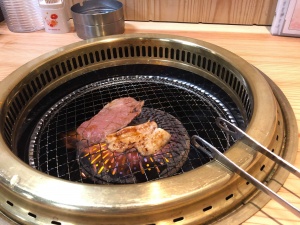
A personal BBQ
Moving beyond sushi and tempura, we did enjoy delicious Kobe beef, cooked at the table and a yummy pancake like mixture popular in Hiroshima.
Best joke: As a very polite society, ‘hello,’ ‘please,’ and particularly ‘thank you,’ are vital. Thank you in Japanese is: arigato (gozaimasu) … this sounds much like ‘alligator’, however Australians often struggle with the pronunciation and say; ‘crocodile.’ 🙂
The South
From Kyoto we again sped south for two hours to Hiroshima. That very appealing city will always be known for the atom bomb, but the area is airy and green. Upon arrival we visited Miyajima – a town of 2000 located on an island south of the city.
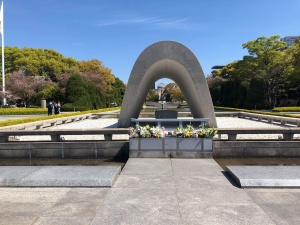
The Hiroshima Peace Park
Deer also walk the street and the shrine is iconic. This is one of the most visited natural areas in the country and offers some green rest away from the concrete.
Hiroshima is obviously very modern. The city is attractive and the peace park very matter of fact.
For more on Hiroshima, please visit the Hiroshima blog .
We gradually drive north up to Kurashiki. The sun stayed with us and we enjoyed traditional architecture and saw Japanese enjoying their weekend dressed up as movie characters. This ‘Cosplay’ is a cultural peculiarity and so far outside my understanding I can only offer bewildered amusement.
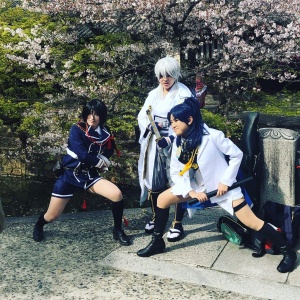
Cosplay ….
On our last full day it rained and rained, but we were still awed by the magnificent Himeji Castle. This is the best of Japanese medieval architecture and the flowers brought it all to life.
And then up to Kobe. Unfortunately the rain limited walking, but it is a fitting finish to an excellent trip. Kobe is wedged between mountains and ocean and is a true culinary destination. Kobe beef, cooked at the table was a perfect final meal for an outstanding journey.
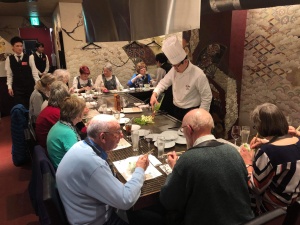
Kobe beef 🙂
I’m not sure I would ever live in Japan. The concrete is monotonous and the culture lacks the diversity we celebrate in more immigrant-based societies, but the quality of service, efficiency and refinement of Japanese society is something everyone should experience.
Arigatou Gozaimasu
[supsystic-gallery id=7]
Please follow and like us:


